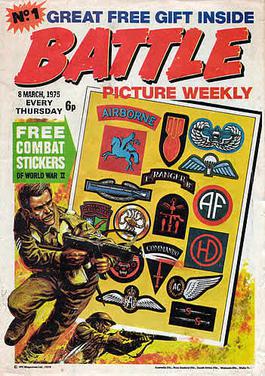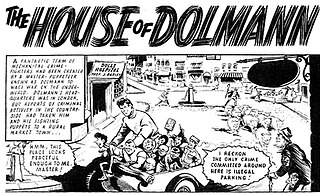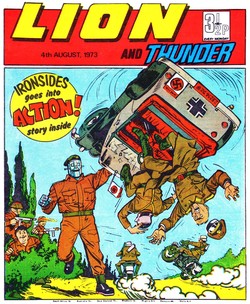
Crisis was a British comic anthology published by Fleetway Publications from 17 September 1988 to October 1991, initially fortnightly and later monthly. Designed to appeal to older readers than other Fleetway titles in order to take advantage of a boom in interest in 'adult' comics, Crisis featured overtly political and complex stories; one issue was even produced in conjunction with Amnesty International.

Battle Picture Weekly was a British weekly boys' war comic published by IPC Magazines from 8 March 1975 to 23 January 1988, when it merged with the new incarnation of Eagle after 644 issues. Most stories were set in World War II, with some based on other conflicts, while factual features also focused on warfare.

"The Thirteenth Floor" is a British science fiction strip character, appearing in titles published by IPC Magazines. The strip debuted in the weekly anthology Scream! on 24 March 1984, before continuing in Eagle until 28 February 1987. The stories were written by John Wagner and Alan Grant; art was provided by José Ortiz. Since 2016 the property has been owned by Rebellion Developments, who have revived the strip in several specials. The plot was set in a tower block called Maxwell Tower, controlled by an experimental sentient computer called Max located on the 13th floor of the flats. Max himself narrated the strip, and as befitting a computerised custodian of hundreds of people, was quite chatty and light-hearted. However, he was also portrayed as having a programming flaw; programmed to love and protect his tenants, he could remorselessly kill anyone who threatened or even just annoyed them.

Tornado was a British weekly boys' adventure comic published by IPC Magazines from 24 March to 18 August 1979. The comic was partly created as a way to use up stories already commissioned for the other titles, and was marred by a difficult production. Tornado sold poorly and was merged with 2000 AD after 22 issues.

Lion was a weekly British comics periodical published by Amalgamated Press from 23 February 1952 to 18 May 1974. A boys' adventure comic, Lion was originally designed to compete with Eagle, the popular weekly comic published by Hulton Press that had introduced Dan Dare. It debuted numerous memorable characters, including Captain Condor, Robot Archie, Paddy Payne and the Spider. Lion lasted for 1,156 issues before being merged with stablemate Valiant.

Valiant was a weekly British comics periodical published by Fleetway Publications and later IPC Magazines from 4 October 1962 to 16 October 1976. A boys' adventure comic, it debuted numerous memorable characters, including Captain Hurricane, The Steel Claw and Mytek the Mighty. Valiant lasted for 712 issues before being merged with stablemate Battle Picture Weekly.

"The House of Dolmann" is a British comic strip published by Fleetway Publications and later IPC Magazines in the boys' comic anthology title Valiant between 29 October 1966 to 11 April 1970, with a brief revival from 7 September to 26 October 1974. Written by Tom Tully and primarily illustrated by Eric Bradbury, the strip centred on the exploits of genius inventor Eric Dolmann and his army of crime-fighting robot 'puppets'.

Treasury of British Comics is a line of comic book collections published by Rebellion Developments, collecting British comics stories from the libraries of Amalgamated Press/Fleetway Publications/IPC Magazines.

Wildcat was a fortnightly British comics periodical published by Fleetway Publications from 22 October 1988 to 25 March 1989. A science fiction adventure comic, the title only lasted for 12 editions before being merged with another Fleetway title, Eagle.

Major Eazy is a British comic character, appearing in strips published by IPC Magazines. Eazy featured British comic war stories published in the weekly anthology Battle Picture Weekly from 10 January 1976 to 10 June 1978, written by Alan Hebden and drawn by Carlos Ezquerra. Set during World War II, the strips follow Eazy, an unconventional British Army officer with a laidback attitude.
Battler Britton is a British comics character created by Mike Butterworth and Geoff Campion. He first appeared in Amalgamated Press' Sun in 1956, and later featured in Knockout, and the long-running digest titles Thriller Picture Library, Air Ace Picture Library, and War Picture Library.

Thunder was a weekly British comics periodical published by Fleetway Publications from 17 October 1970 to 13 March 1971. A boys' adventure comic, the title only lasted for 22 editions before being merged with another Fleetway title, the long-established Lion.

The Steel Commando is a British comic character, appearing in strips published by IPC Magazines. Created by Frank S. Pepper, the character first appeared in the first issue of the short-lived boys' weekly adventure anthology comic Thunder, dated 17 October 1970. After Thunder ended in March 1971 the strip continued in Lion until 1974. The character is a robotic soldier fighting for the British Army in World War II; due to a programming error the mechanical man will only obey the orders of layabout Private Ernest 'Excused Boots' Bates.

"The Indestructible Man" is a British comic strip published by Fleetway Publications and later IPC Magazines in the boys' comic anthology title Jag between 4 May 1968 to 29 March 1969. Written by Scott Goodall and drawn by Jesús Blasco, the story followed an Ancient Egyptian warrior who survived into the present day after learning a number of skills while entombed, and took on the identity of crime-fighter Mark Dangerfield.

"D-Day Dawson" is a British comic war story published in the weekly anthology Battle Picture Weekly from 8 March 1975 to 22 January 1977 by IPC Magazines. Set during World War II, the story follows Steve Dawson, a sergeant in the British Army left with an inoperable bullet next to his heart after being shot during the D-Day landings.

"The Bootneck Boy" is a British comic war story published in the weekly anthology Battle Picture Weekly from 8 March 1975 to 12 November 1977 by IPC Magazines. Set during World War II, the story follows Danny Budd, a youth from the fictional Northern England town of Tynecastle as he strives to join the Royal Marines.

"Death Squad" is a British comic war story published in the weekly anthology Battle from 12 July 1980 to 4 June 1981 by IPC Magazines. Set during World War II, the story follows a Wehrmacht penal military unit spared death sentences in return for service on the Eastern front. It was written by Alan Hebden and drawn by Eric Bradbury.

"Rat Pack" is a British comic war story published in the weekly anthology Battle Picture Weekly from 8 March 1975 to 8 July 1978 by IPC Magazines. Set during World War II, the story follows the eponymous unit, a penal military unit of four criminals recruited by British Army officer Major Taggart to undertake deadly missions.

"Dredger" is a British comic action story published in the weekly anthologies Action and Battle Action from 14 February 1976 to 7 October 1978 by IPC Magazines. The strip focused on the eponymous, uncompromising secret agent and his partner Breed, featuring self-contained stories that featured Dredger getting out of lethal situations with an innovative and violent approach.

Eagle, sometimes referred to as The New Eagle and known at various points in its life as Eagle and Scream!, Eagle and Tiger, Eagle and Battle, Eagle and M.A.S.K. and Eagle and Wildcat, was a British boys' adventure comic published by IPC Magazines from 27 March 1982 to January 1994. A revival of the famous Eagle, the title was initially a weekly publication until turning into a monthly in May 1991. The title was finally cancelled in January 1994, after 505 issues.



















